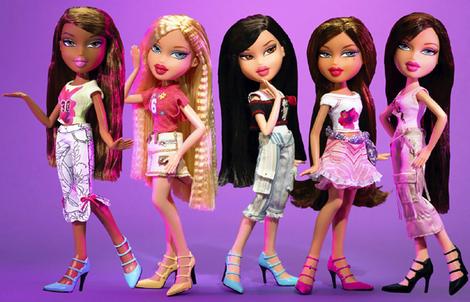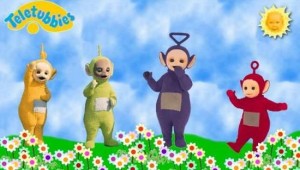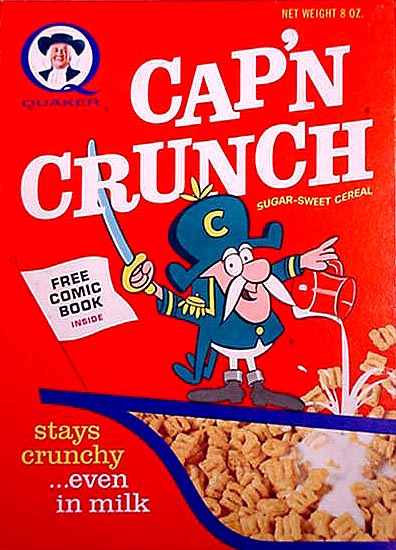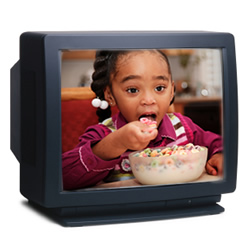Waldorf News
Electric Youth: The Campaign for a Commercial-Free Childhood

By CATHERINE ELTON
Susan Linn is a Harvard Medical School instructor of psychiatry, the author of two books, and one of the country’s leading experts on how marketing and television exposure affect children. and right now, addressing a roomful of concerned parents at a nursery school in Lincoln, she’s got her arm jammed halfway up a puppet of a duck named Audrey. The duck, with its thick yarn braids and button eyes, cranes its neck to get a look at the room, while Linn’s face is frozen in a tooth-clenching grin. “Susan,” says the puppet, the voice seeming to emanate from nowhere, “what are we doing here?”
Linn, an award-winning ventriloquist who in her younger days performed everywhere from the streets of Boston to the set of Mister Rogers’ Neighborhood, today runs the tiny but hugely influential nonprofit Campaign for a Commercial-Free Childhood. The CCFC, as the group is known, is concerned with two overlapping issues: the amount of time children spend in front of an ever-growing array of screens — TVs, computers, smartphones, tablets — and the marketing messages they are subjected to while glued to them.
 Under Linn’s direction, the group has taken on some of the biggest and most powerful corporations in the world. It forced Kellogg to remove SpongeBob SquarePants and other cartoon characters from the packaging of foods that were light on nutritional value. It got Hasbro to shelve plans for a new line of dolls based on the sexpot pop act the Pussycat Dolls (“Don’t cha wish your girlfriend was hot like me?”) that made Bratz dolls look like fat prudes. (If you aren’t familiar with Bratz dolls, by the way, they’re the ones that make Barbie look like a fat prude.) And when Linn found out that a Needham company called BusRadio was airing advertisements on school buses, she organized a campaign that led to the demise of the business.
Under Linn’s direction, the group has taken on some of the biggest and most powerful corporations in the world. It forced Kellogg to remove SpongeBob SquarePants and other cartoon characters from the packaging of foods that were light on nutritional value. It got Hasbro to shelve plans for a new line of dolls based on the sexpot pop act the Pussycat Dolls (“Don’t cha wish your girlfriend was hot like me?”) that made Bratz dolls look like fat prudes. (If you aren’t familiar with Bratz dolls, by the way, they’re the ones that make Barbie look like a fat prude.) And when Linn found out that a Needham company called BusRadio was airing advertisements on school buses, she organized a campaign that led to the demise of the business.
Then there was the CCFC’s action last spring against Scholastic, the world’s largest publisher and distributor of children’s books, and home to such beloved characters as Clifford the Big Red Dog and Harry Potter. Scholastic was distributing fourth-grade learning materials that outlined various sources of power, placing a special emphasis on the virtues of coal. It turned out that the coal industry had paid for and developed the whole thing. “In these materials there was not one mention about coal’s negative impacts,” Linn says. “However you feel about coal, there needs to be both sides in teaching materials.” So she launched a campaign against Scholastic — an action that was covered the very next day in the New York Times. The day after that, the paper wrote an editorial chastising the company. And the day after that, Scholastic announced it was dropping the curriculum. But Linn didn’t stop there. She partnered with the website Change.org to get more than 56,000 people to write to Scholastic demanding that it rid itself of all corporate-sponsored teaching materials. In August, the company announced it was dramatically scaling back on them.
All of which has made Linn a hero to concerned parents and prominent academics across the country. “She is very strategic in the targets she picks and very principled in pursuit of efforts to try to mitigate commercial exploitation of children,” says University of Arizona professor of communication Dale Kunkel, who is a psychologist and leading researcher in the field. Anne Deysher, a grandmother and former preschool teacher who lives in Westborough, was so impressed with Linn that she became one of the CCFC’s 48,000 members. “She is a voice in the wilderness,” Deysher says. “It is very courageous to step up with such passion and well-informed ideas and try to make waves in the face of such daunting opposition with such incredible resources.”
It’s true that Linn has made a kind of habit of taking on, and besting, corporations with vastly more resources than she has at her disposal. But that’s not to say that there haven’t been a few repercussions along the way. In fact, one fight she picked — against the mammoth Walt Disney Company and its wildly popular Baby Einstein line — nearly cost her everything she’d spent her career building.
 Since 1999, the American Academy of Pediatrics (AAP) has recommended that children younger than two avoid “screen time” entirely. Research has shown that watching screen media can lead to irregular sleep patterns in infants, and it also may be associated with attention problems, delays in language acquisition, aggressive behavior, and lower achievement in school later on. What’s more, there’s evidence that spending time in front of screens keeps infants from doing things that are proven to be beneficial to their development: interacting with adults and simply playing.
Since 1999, the American Academy of Pediatrics (AAP) has recommended that children younger than two avoid “screen time” entirely. Research has shown that watching screen media can lead to irregular sleep patterns in infants, and it also may be associated with attention problems, delays in language acquisition, aggressive behavior, and lower achievement in school later on. What’s more, there’s evidence that spending time in front of screens keeps infants from doing things that are proven to be beneficial to their development: interacting with adults and simply playing.
Despite all this, a 2007 University of Washington study found that 90 percent of parents let their kids under two watch at least some screen media. And according to a 2006 Kaiser Family Foundation study, 14 percent of children ages 6 to 23 months are exposed to two or more hours a day of electronic media.
Screen time also appears to be habit-forming. The University of Washington study found that children who watched TV when they were younger were more likely to protest when they were older and someone tried to turn off the set. And a 2010 Kaiser Family Foundation study found that children between 8 and 18 years old were exposed to an average of seven and a half hours a day of screen time — an increase of an hour and 17 minutes in just five years. (To put that into perspective, screen time had increased by just two minutes in the previous five-year period.) Experts find all of this especially alarming because excessive viewing by school-age children is associated with psychological, physical, and social problems.
Beyond the effects of screen time itself on youngsters, there’s what they’re actually watching. The screens are platforms for an avalanche of marketing messages that target children. According to James McNeal, professor emeritus at Texas A & M and a pioneering researcher in the field of marketing to children, companies spend around $4.5 billion a year advertising products to children between the ages of 2 and 16. And Kunkel, the University of Arizona professor, says that scientific studies have shown that children under eight cannot understand the persuasive intent of advertising. At a fundamental level, then, advertising to children is simply unfair.
So it’s not surprising that the practice is either banned or restricted in some countries, Sweden, Norway, and Greece among them. When the Federal Trade Commission tried to limit advertising to children in the 1970s in the U.S., it was met with a backlash from corporations and the public. Soon after, Congress reduced the FTC’s powers and restricted its funding. If hobbling the FTC weren’t enough, the Federal Communications Commission under the Reagan administration ended specific guidelines governing ads that are aimed at kids. That change in 1984 led to the advent of what were essentially program-length commercials for toys. He-Man and the Masters of the Universe and Teenage Mutant Ninja Turtles weren’t just cartoons — they were extended advertisements for action figures, apparel, and all manner of licensed products.
There’s also the fact that the products in commercials for children are often violent, hypersexualized, or fattening. That’s a problem, because, according to the AAP, there are more than 2,000 scientific studies showing that exposure to violent media increases the risk of aggressive behavior in children and adolescents, and because research has also documented a link between screen time and obesity in children. That could simply be the result of sitting around all day in front of the TV, or it could be from watching so many of the ads for crappy food that are aimed at children — more than $2.3 billion worth in 2006, according to the FTC. And if all that weren’t enough, emerging research suggests that the sexual content that characterizes so much of modern advertising may be linked to early sexual intercourse among teenagers.
If anything, the problem is only getting worse. Boston College sociologist Juliet Schor characterizes the past decade as a “race to the bottom in terms of the ethics of advertising to children.”
 That’s at least in part because of the explosion of screens. They’re everywhere now, from Dad’s tablet to Mom’s smartphone to the DVD player in the car. Kunkel cites previous research showing that children are exposed to 40,000 TV ads a year. That’s probably come down some, he says, because children are spending less time watching television. The bad news, however, is that they’re spending a lot more time looking at other types of screens. The FCC restricts the time that networks can broadcast ads, but the Internet is a Wild West. So advertisers now use spots on TV to try to get kids to move to the Web, where they can spend unlimited amounts of time playing so-called advergames on sites that promote children-focused products. Add it all up, and children are actually being subjected to more ads than ever. “Kids are exposed to marketing messages in their entertainment, in their schools, and on screens in the checkout aisles at the supermarket,” Kunkel says. “They can’t get away from them. They are more pervasive than ever before.”
That’s at least in part because of the explosion of screens. They’re everywhere now, from Dad’s tablet to Mom’s smartphone to the DVD player in the car. Kunkel cites previous research showing that children are exposed to 40,000 TV ads a year. That’s probably come down some, he says, because children are spending less time watching television. The bad news, however, is that they’re spending a lot more time looking at other types of screens. The FCC restricts the time that networks can broadcast ads, but the Internet is a Wild West. So advertisers now use spots on TV to try to get kids to move to the Web, where they can spend unlimited amounts of time playing so-called advergames on sites that promote children-focused products. Add it all up, and children are actually being subjected to more ads than ever. “Kids are exposed to marketing messages in their entertainment, in their schools, and on screens in the checkout aisles at the supermarket,” Kunkel says. “They can’t get away from them. They are more pervasive than ever before.”
In the past 10 years, we’ve also seen, for the first time, the advent of media — games, apps, and even an entire television network — aimed at babies and toddlers. Why? In some ways it’s to get them hooked early, so when they get older they can nag their parents into making purchases. Texas A & M’s McNeal estimates that advertisers spend $50 billion a year marketing products to kids ages zero to 16. That’s actually a pretty good investment, since McNeal says those kids now influence an estimated $1.2 trillion dollars in spending by their parents each year.
McNeal has grown increasingly critical of the practice of advertising to children. Kids and parents need more government protection, he says, because the marketing industry “has learned it can do and say what it wants to without any legal recourse.”
Greg Livingston, coauthor of Marketing to the New Super Consumer: Mom and Kid, insists that the industry and television networks do a very good job of self-policing, and that their own guidelines are becoming ever-more stringent. “Companies have a right to share and make individuals — be they younger or older — aware that their product exists,” Livingston says. And besides, he says, his own research shows that mothers like their children to tell them what they want them to buy, because today’s moms don’t have the time or money to purchase a food or toy their kids won’t eat or play with.
But BC’s Schor says there’s simply no doubt that the federal government should be looking out for kids. “It shouldn’t be the job of Susan Linn to do what she is doing, or even the job of parents,” Schor says. “The government should be doing it, because children are unable to protect themselves from the harmful practices of corporations.”
Linn was six years old and living in Detroit when she saw ventriloquist Paul Winchell and his dummy Jerry Mahoney on TV in the early 1950s. Fascinated, she began experimenting with ventriloquism herself. In time, her parents hired a professional coach to give her lessons, and she has never lost her love for the craft. In fact, she dropped out of Boston University’s theater program at 19 to pursue a career as a ventriloquist.
 After leaving BU, Linn performed street theater for Boston’s summer arts festival, made occasional appearances on the local TV show Major Mudd, and traveled and performed with Pete Seeger. For three weeks in 1967, she toured New England performing with an accordion player, a clown who did cigarette manipulations, and an alcoholic banjo player in a Santa suit. That same year, Linn was sitting in her fourth-floor apartment above a Kenmore Square pizzeria when she saw Mister Rogers’ Neighborhood for the first time.
After leaving BU, Linn performed street theater for Boston’s summer arts festival, made occasional appearances on the local TV show Major Mudd, and traveled and performed with Pete Seeger. For three weeks in 1967, she toured New England performing with an accordion player, a clown who did cigarette manipulations, and an alcoholic banjo player in a Santa suit. That same year, Linn was sitting in her fourth-floor apartment above a Kenmore Square pizzeria when she saw Mister Rogers’ Neighborhood for the first time.
“I was blown away that he was using television to address issues in child development,” she recalls. “I knew I wanted to do what he was doing.” So she typed up a letter to Fred Rogers’s show, saying how impressed she was with the “honesty and gentleness with which the material is presented,” and asking for an audition. Rogers invited Linn and her puppets to come to Pittsburgh for an audition, but he didn’t wind up offering her an appearance on the show. To this day, though, Linn recalls him saying, “It was evident that I really remembered what it was like to be a child.”
A year later, Linn was back in college, studying psychology at UMass Boston, when she received a surprise letter. It was from a Rogers producer, and this time he wanted her on his show — an invitation that would lead to a string of appearances. In one of her first episodes, in 1971, Rogers, Linn, and an early incarnation of Audrey Duck try to work through Audrey’s jealousy of another Linn puppet, Catalion. Linn is wide-eyed and smiles warmly at her yarn-and-fabric charges. “Oh, Audrey, I don’t think Mr. Rogers will like Catalion better than he likes you,” she assures her in the slow and honey-tinged way television actors once spoke to children.
Linn would appear several more times on the show, and also continue her own live performances for children. “Ultimately, I want to do the sort of thing you are doing,” she wrote to Rogers in a 1973 letter. “Use media to help children with their growth and development.” That quest would lead her to pursue a doctorate in counseling psychology, and also a job at Children’s Hospital, where she used Audrey Duck and Catalion to help very sick children cope with their illness. “It’s an unusual skill she has,” says Children’s Hospital psychiatrist William Beardslee, “to be able to enter into the world of children and understand them and be able to take action. Susan really came to understand what those children’s experiences of being hospitalized were like. Giving kids the opportunity to use puppets as a vehicle for expression was very powerful.”
Beardslee and Linn would go on to partner with the Fred Rogers production company to make a series of videos aimed at helping children cope with difficult situations. In the early 1990s, they took on the topic of racism, beginning a collaboration with the famed Harvard child psychologist and civil rights activist Alvin Poussaint, who is perhaps best known for his work on The Cosby Show.
In 1994, the Judge Baker Children’s Center at Harvard launched a media center that had the goal of working with “media to promote healthy child development and to mitigate its negative effects.” Judge Baker made Poussaint director of the new media center, and he asked Linn to come work with him. Before long, they won a grant to produce their own television show, which they called Willoughby’s Wonders. Their goal was to create an educational and entertaining show about an ethnically diverse, urban soccer team. The pilot, shot on a shoestring, won awards, but they quickly realized how expensive it would be to turn that first episode into a full-blown series. McDonald’s offered to offset the cost by sponsoring some of the show, but that would have meant having the characters wear McDonald’s shirts, or creating a character who worked at a McDonald’s restaurant, Poussaint and Linn say. Another funding option, suggested by a colleague, was to have the characters wear some object, like a bracelet, that could then be sold to kids to raise money for the show. But Linn and Poussaint objected to both product placement and tie-in toys. In the end, the series was never made.
 Raising a daughter in Brookline, Linn was already concerned about the effects of commercialism on children, but she says the experience of trying to fund a show was a “crystallizing moment for me about what was going on in media.” Still, it took a few more years, and the arrival in America of a band of four colorful, lovable aliens, to convert Linn from a budding television producer trying to use the medium to help children to an activist who saw it as something from which they needed protection.
Raising a daughter in Brookline, Linn was already concerned about the effects of commercialism on children, but she says the experience of trying to fund a show was a “crystallizing moment for me about what was going on in media.” Still, it took a few more years, and the arrival in America of a band of four colorful, lovable aliens, to convert Linn from a budding television producer trying to use the medium to help children to an activist who saw it as something from which they needed protection.
In 1998, PBS imported Teletubbies from Britain, marking the first time a television show directed at children as young as 12 months was aired in this country. Linn found the show “brilliant and diabolical” in how it was clearly designed to hold the attention of babies. In a 1999 American Prospect article, she took the show to task for its claims that it was educational — claims, she wrote, that were unfounded.
“We predicted it would open the floodgates of television aimed at babies,” Linn says now. “And we were right.” With that in mind, Linn, Poussaint, and a small group of academics and healthcare professionals formed a new project a few months later at Judge Baker’s media center: the Campaign for a Commercial-Free Childhood. The ventriloquist had found her voice.
At a Boston Medical Center project for sick children in Mattapan one day last fall, a group of doctoral students have gathered to listen to Linn speak about the effects of media, and about play-based therapy. A photo of a sock puppet appears on the screen during the presentation, and Linn asks the students, who are all interning at the project, to describe what they’re looking at. A worm, says one. A boy, says another. Someone else says a girl.
“And what does that say?” asks Linn. “Anything, right? And that’s because what it is resides in you.”
Seconds later, a slide comes up of a googly-eyed blue monster. This time, everyone knows exactly who they’re looking at, as well as his name. And when Linn asks what he’s most known for saying, the interns erupt in a simultaneous rendition of a throaty, cookie-scarfing growl, before succumbing to laughter. “There you have it,” she says. “Children play less creatively with media-linked toys. Now suppose this is embedded with a computer chip. What use is that to a child? Yet these are the most-advertised kind of toys.”
In a sense, the best way to understand the companies and products that Susan Linn is against — and there is no lack of material for her activism — is to understand what it is that she’s for: the simple, educational, therapeutic act of unscripted, unbranded, and unbridled play. Whether she’s speaking to the students before her now or the parents she meets with so often, she is careful to never come across as shrill, despite her outrage over what she believes the advertising and marketing industries are doing to children. Rather than anger, she projects a therapist’s calm.
Linn’s impressive list of successful campaigns has won her millions of adoring fans. But judging from her hate mail (she keeps a bucket filled with it in her office), she’s got plenty of detractors, too. She’s been judged a fascist, a communist (sometimes in the same letter), a Harvard snob, and a publicity hound. Her critics interpret her campaigns against marketers as attempts to dictate how parents should raise their children. She’s been accused of being hostile to fun. But no action she has ever taken has resulted in attacks as ferocious as the ones she sustained after picking a very public fight with Disney and its Baby Einstein line of “educational” videos and products.
In late 1996, a mother and former teacher named Julie Aigner-Clark shot the first Baby Einstein video in her basement. Aigner-Clark’s marketing promised that the video would increase the brain capacity of babies. Later offerings carried additional claims of educational benefits. The videos, snatched up by well-intentioned parents looking to give their kids an advantage, won awards and even showed up on Oprah. In 2001 Aigner-Clark sold the company to Disney for $25 million. By 2003 a third of all American infants had at least one Baby Einstein video.
But the truth was, there was no evidence that Baby Einstein had any educational value. The CCFC made that point in a complaint it filed with the FTC in 2006, accusing Baby Einstein of deceptive advertising. The next year, Disney ceased making the educational claims, and the FTC therefore decided not to make a determination on the merits of the CCFC complaint. While Linn was thrilled that Disney was no longer calling Baby Einstein educational, she believed that the FTC’s decision to simply drop her complaint essentially told corporations that it was okay to lie to parents until you got caught.
 With that in mind, Linn contacted lawyers, who sent Disney a letter of intent to sue on behalf of consumers who’d bought the videos during the specific time frame when they were being marketed as educational. (Disney wound up settling, but the terms of that settlement remain confidential.) In September 2009 Disney agreed to offer a full refund to anyone who’d purchased a Baby Einstein video between June 5, 2004, and September 5, 2009. But Linn says the company buried the offer on the Baby Einstein website, and included no explanation as to why the refund was being given in the first place. Linn wanted the public to know why Disney was offering the refund, so she called a reporter at the New York Times. The paper ran a front-page story in late October 2009, reporting on the refund policy and calling it a “tacit admission that they did not increase infant intellect.” Baby Einstein posted a notice on its website denying any such admission; characterizing the refund as nothing more than business as usual for its customer-satisfaction department; and accusing Linn of waging a “smear campaign” against the company in order to gain publicity and donations.
With that in mind, Linn contacted lawyers, who sent Disney a letter of intent to sue on behalf of consumers who’d bought the videos during the specific time frame when they were being marketed as educational. (Disney wound up settling, but the terms of that settlement remain confidential.) In September 2009 Disney agreed to offer a full refund to anyone who’d purchased a Baby Einstein video between June 5, 2004, and September 5, 2009. But Linn says the company buried the offer on the Baby Einstein website, and included no explanation as to why the refund was being given in the first place. Linn wanted the public to know why Disney was offering the refund, so she called a reporter at the New York Times. The paper ran a front-page story in late October 2009, reporting on the refund policy and calling it a “tacit admission that they did not increase infant intellect.” Baby Einstein posted a notice on its website denying any such admission; characterizing the refund as nothing more than business as usual for its customer-satisfaction department; and accusing Linn of waging a “smear campaign” against the company in order to gain publicity and donations.
What Linn never expected, however, was that the critics of her Baby Einstein work would include her own employers. Days after the Times article and the flood of coverage that followed, Linn happened to be in Seattle when she got a frantic phone call from Poussaint. He told her that the Judge Baker center board was furious with both of them. Apparently, he says today, Disney had contacted the center several times to complain.
According to Linn and Poussaint, the board wanted them to stop talking to the press and to tone down their campaigns against corporations. From the perspective of Linn and Poussaint, then, the board was telling the CCFC to quit doing the very thing it existed to do. When they refused, they say, the board told them they were evaluating the future of the CCFC. Poussaint assumed the whole thing would blow over, especially since Judge Baker was gearing up to honor him with its 2010 World of Children Award at a lavish gala scheduled for March. Linn, though, was convinced she was going to lose her job.
Over the course of the next month, as the CCFC waited for its fate to be determined, anything the group wanted to post on its website had to be cleared by Judge Baker, says CCFC associate director Josh Golin. The CCFC was also prevented from giving out its annual award for the worst children’s toy. Finally, in January 2010, Linn was informed that Judge Baker was shutting down her project, and that the group had a month to get out. That was bad enough, but there was even more at stake than just Linn’s and Golin’s jobs. Judge Baker owned the CCFC’s name, materials, and contact list. The very existence of the group was at risk.
Speculation began to grow in the national media as to why the board acted this way with a project the Judge Baker staff used to brag about to reporters and spotlight in its annual report. Had Disney threatened to sue? Was the Judge Baker board, which features many executives from prominent law and financial firms, simply uncomfortable with the CCFC’s campaigns against big companies? Was Judge Baker concerned that such campaigns could have a chilling effect on corporate donations? All of those questions remain unanswered. Disney didn’t respond to requests for an interview, and all Judge Baker would say in an e-mail was that “its own mission, staff, and infrastructure were not well suited to provide appropriate context for an advocacy program of this nature.”
Whatever the reason for ejecting the CCFC, it was not without its repercussions. It was covered in national newspapers, and the Globe ran an editorial accusing Judge Baker of “bowing” to corporate pressure. By that time, the invitations to the gala honoring Poussaint had already gone out and people were set to fly in from all over the world. Tens of thousands of dollars had been spent on the affair. “I was enraged,” Poussaint says. “Here they were about to give me an award, and at the same time they were kicking my program out of the center. I told them I couldn’t accept the award.”
In the end, things turned out well for the CCFC. Linn and Golin were able to negotiate a deal in which they took the campaign’s name, materials, and contact list with them when they moved out of the Judge Baker center in February 2010. Two days later, they were up and running in South Street offices provided by the nonprofit Third Sector New England, which gives them essentially what Judge Baker did: office space, infrastructure, and health insurance. The CCFC does its own fundraising to cover other expenses. (Linn has always taken a half-time salary.)
Poussaint terminated his relationship with Judge Baker and moved his offices to the Harvard Medical School. While he’s still on the CCFC steering committee, he and Linn no longer talk several times a day, something Linn describes as an “ongoing sadness.” Otherwise, though, the campaign is thriving in its new home.
Last spring brought the CCFC’s successful campaign against Scholastic over the coal materials it was distributing — the group’s first major victory since leaving Judge Baker. “It was evidence that we had survived what was potentially a fatal blow,” Linn says.
Another thing that’s survived is the demand for Linn to speak to parent groups, like the ones she’s addressing right now at the Lincoln nursery school. Surveying the crowd before her, Audrey Duck looks up and sees a PowerPoint slide on a big screen.
“Oh, no!” the puppet gasps. “Are we talking about the commercialization of childhood again?”
“Well, yeah, actually we are, Audrey,” Linn says.
“Haven’t you fixed it yet?” says Audrey Duck.
“No, I haven’t fixed it yet,” says Linn. “It is going to take a long time.”
Originally published in Boston Magazine, February 2012.
 Association for a Healing Education
Association for a Healing Education Immersive Academics and Arts
Immersive Academics and Arts Jamie York Books, Resources, Workshops
Jamie York Books, Resources, Workshops Bay Area Teacher Training
Bay Area Teacher Training Space speaks. Its language is movement.
Space speaks. Its language is movement. Waldorf Training in Australia
Waldorf Training in Australia Waldorf-inspired Homeschool Curriculum
Waldorf-inspired Homeschool Curriculum
 Everything a Teacher Needs
Everything a Teacher Needs Transforming Voices Worldwide
Transforming Voices Worldwide The Journey is Everything
The Journey is Everything Great books for Waldorf Teachers & Families
Great books for Waldorf Teachers & Families Train to Teach in Seattle
Train to Teach in Seattle Caring for All Stages of Life
Caring for All Stages of Life Bringing Love to Learning for a Lifetime
Bringing Love to Learning for a Lifetime Flexible preparation for your new grade
Flexible preparation for your new grade Summer Programs - Culminating Class Trips
Summer Programs - Culminating Class Trips Roadmap to Literacy Books & Courses
Roadmap to Literacy Books & Courses Quality Education in the Heartland
Quality Education in the Heartland ~ Ensoul Your World With Color ~
~ Ensoul Your World With Color ~ Apply Today: New Cohort Starts Nov. 2025
Apply Today: New Cohort Starts Nov. 2025 Middle School Science With Roberto Trostli
Middle School Science With Roberto Trostli Full-Time Teacher Education
Full-Time Teacher Education RSS Feeds
RSS Feeds